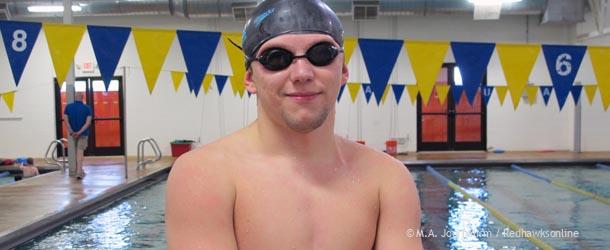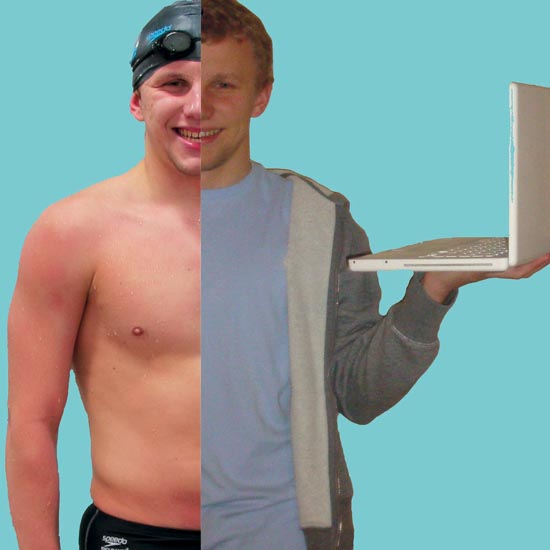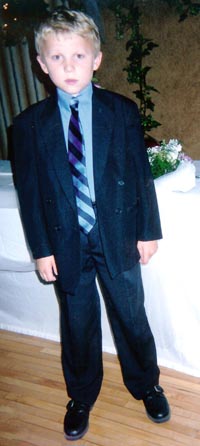Donkersgoed has success, wisdom beyond his years
There are 150,000 people staring and 50 television cameras running as a long whistle sounds, signaling for athletes to climb onto their blocks. Suddenly, the crowd surrounding the pool adopts a thick silence as the referee’s hands extend to the starter.
On lane eight’s block there’s a swimmer who’s poised ready to make his mark – the next of the many marks he’s already made on the swimming world and on those who’ve crossed his path.
From lane eight, Van Donkersgoed went on to swim in the 2009 World Championship Trials in Indianapolis; one of many prestigious competitions Donkersgoed has participated in over the past seven years.
At Minnehaha, Donkersgoed, who will graduate next weekend, may very well be the most famous athlete no one has ever seen perform. Some may have heard of his travels to Orlando, Barcelona and California or maybe his success at a national meet, but Donkersgoed’s role in the sport of swimming goes far deeper than the water in the pool.
He’s managed to influence the sport itself, on local and national levels. But his story doesn’t start with swimming; in fact, it may all be symbolized by a tiny suit – and not the swimming kind.
“He wore a [business] suit and his Geoffrey Beene silver buckle shoes to kindergarten every day,” explained Van’s mother, Sue Donkersgoed. “I remember asking him, ‘Do you really want to wear this?’ and he would just say, ‘I am who I am, and I just don’t care what people think.'”
When there’s a technical problem in chapel or assembly, “everybody screams ‘Van!’ to say ‘thanks for fixing the microphone, and oh yeah, thanks for being such a role model,” said senior Madeline Myers. “I think it’s because Van defies everything we know about high school stereotypes, and our student body admires that.”
In addition to swimming up to 42,000 yards on a weekly basis, Donkersgoed is also considered a “second tech director,” according to Tech Director Brian Hallermann. This has allowed Donkersgoed to find a much-needed balance in his non-stop life.
“My work with the theater program lets me get away from anything and everything that has to do with swimming,” said Donkersgoed, as he pushed an imaginary beach ball aside with his hands. “I’m on a stage when I swim, so being behind the scenes with tech gives me a different perspective.”
And he’s good at it, too.
“He blows me away sometimes,” said Hallermann. “When he came to [North Campus, Principal Nancy] Johnson told me I had to talk to him because I needed him on the [tech] team. She said, ‘you can give this kid the keys to the place, and [he’ll make it] a better place than when you left it.'”
But Donkersgoed’s incentive to put in maximum hours and effort as a techie doesn’t stem from the attention he receives from his peers; he does it because he enjoys it.
“I’ve learned that it’s okay to fail,” said Donkersgoed. “It’s taught me how to think on my toes. I don’t think I’ve ever done the same thing twice. It keeps me entertained.”
“Plus I get to play with a lot of cool toys,” he added with a grin that made his eyes squint shut and a chuckle that shook his whole body.
Defying the norms within the walls of Minnehaha and beyond seems to have always been, well, a norm for Donkersgoed – and it started early.
“When he was three years old he was using three syllable words,” said Sue Donkersgoed.
While he may have been advanced in his articulate abilities that are still evident today, Donkersgoed got a slow start in the world that has managed to determine his fast-approaching future – swimming.
Starting at age 11, he was already about three years behind by the standards of competitive swimming.
“I remember sitting in the hot tub at the health club and seeing these people swim up and down the pool,” recalled Donkersgoed. “I thought it looked fun.”
Fun. A simple reason for making a decision that would eventually change his life. He joined Aquajets Swim Team of Eden Prairie soon after that thought.
“On Van’s first day, I talked to one of my coaches and said, ‘I think he might find better luck in another sport,'” remembered Kate Lundsten, head coach of Aquajets, “but then we saw his breaststroke and that all changed.”
It’s all about the baby steps. Just as Donkersgoed took strides towards maturity, similar progressions were made in his swimming.
“In my first meet, no one told me you had to touch the wall with two hands at the end of the pool,” recalled Donkersgoed, as one of his sarcastic smiles began to creep across his face. “So I did a flip turn and got disqualified.”
Needless to say, Donkersgoed recovered from the rough waters of his early career very quickly,
and by 2006, at the age of12, he was competing with Team Minnesota in Indianapolis at one of the country’s most prestigious pools.
“He just took [his swimming] in strides,” said Lundsten, “one little step at a time.”
With many more little steps and even more hours training in the pool, Van was catapulted into the spotlight at the 2009 National Club Swimming Association Junior Nationals in Orlando, Fla., where he had, in swimming language, his “breakout swim.”
The articulate, young swimmer didn’t need multisyllabic words to describe that race.
“I just went really fast,” Donkersgoed said, as he leaned forward in his chair. “I realized I could actually do something in the sport.”
Donkersgoed’s swimming seems to be about more than just going fast. “There are very few young men as passionate about swimming – or about anything – as [Donkersgoed] is,” said Lundsten. “He gets swimming, he studies swimming, and that sets him apart.”
In one of his many sophisticated analyses, Donkersgoed explained how he finds meaning in the sport.
“There’s something greater at play when we compete,” explained Donkersgoed. “I think the direct action of swimming is not glorifying God, but it’s more about how you conduct yourself in the failures, in the successes, and how you interact with the people around you. You learn a lot about [yourself] that way.”
In November 2010, however, his fortunes took a dark turn.
“I had a headache at swim practice, and it just kept getting worse,” Donkersgoed recalled, as he clenched his fists. “We just couldn’t figure it out.”
Some doctors thought he had spinal fluid back up, then some thought it was a blood issue. Donkersgoed was enduring muscular and vascular migraines from 9 a.m. to 3 p.m. almost every day.
“Swimming gave me something to want to get better for,” explained Donkersgoed. “The water became a very healing thing for me.”
Lundsten seemed to recall this point of Donkersgoed’s career with a twinge.
“He was in such incredible pain it was unbelievable,” said Lundsten. “It got to a point where he really wasn’t able to physically swim, so it opened up new doors for him.”
While his family waited for answers, the relentless curiosity of Donkersgoed didn’t let his health stop him from becoming a nationally known swimmer – without even skimming the water.
Donkersgoed has managed to influence swimming as a whole through his role as an athlete representative on both local and national committees that govern the very rules of the sport.
“He’s on the National Rules Committee , which is unheard of for [someone] his age,” said Lundsten.
Claire Letendre, who lives in Atlanta, and is on the National Rules/Regulations Committee with Donkersgoed, sees Donkersgoed in an entirely unique setting.
“He isn’t afraid to ask questions,” said Letendre. “He seems to be beyond his years when he speaks.”
While Donkersgoed stayed busy by transforming the language of the national rulebook, volunteering his time for several other local committees and lending his knowledge to the National Board of Review, which he describes as the Supreme Court ofUSA Swimming, he waited for answers about his health.
“I just wanted to be normal,” said Donkersgoed. In November 2011, one year after his headaches started, Donkers- goed went to the Mayo Clinic in Rochester, Minn.
“We were all thinking worst-case scenario,” said Donkersgoed, as he flipped his hands outward and drew them apart. “It was kind of funny.”
Funny? With his sarcastic glance appearing again, he recalled how the doctor at Mayo told him that his current medications where inaccurately prescribed and determined the cause of his headaches: a sinus infection.
“It was the easiest solution we could have asked for,” said Donkersgoed with a shrug.
Full steam ahead, Donkersgoed started getting looks from universities around the country by his sophomore year. With help from a past coach, Northwestern University in Evanston, Ill., caught his attention.
“I wanted a program where I wouldn’t go in as number one,” said Donkersgoed. “I want to go somewhere and be developed. You’re never guaranteed anything in swimming; you have to earn everything.”
His wisdom, just as his swimming, has progressed far beyond the normal expectations of an 18-year-old. He analyzes his relationships with those around him and his actions as a human being with confident clarity.
“Life is about taking the time to care,” said Donkersgoed, as he grasped his chin with his hand for a moment. “My mom taught me that life is about giving back and making a difference, and my dad taught me how to do that efficiently.”
Donkersgoed has already impacted countless lives within the world of swimming and beyond.
“He is a very caring and loving brother,” said Donkersgoed’s 29-year-old brother, Chuck, who has a traumatic brain injury. “He helps me and supports me – he’s a role model in [showing] me how I can be a better person.”
Whether he’s putting on a business suit with dress shoes or a swimming suit, 10 years from now Donkersgoed will be doing what he finds meaning in – what lets him quench his curiosity, what makes him happy and what makes a difference.
“Van used to sit and wait for the garbage truck,” recalled Sue Donkersgoed with a laugh. “He would use the phone like he was calling them to come pick him up. I’ve always said, if Van’s happy being a garbage man, then I’m happy.”
Donkersgoed will undoubtedly stay true to what he told his mom back in kindergarten.
“Success is however you personally perceive it,” said Donkersgoed. “For me, it’s not about any amount of money, it’s about the process behind [finding meaning]. I find meaning in making mistakes, learning, and finding how to be a better person.”
****
The (incredibly) versatile Van Donkersgoed
– Member of 2010-2011 USA Swimming Rules and Regulations Committee
– Elected as Athlete Representative on the Minnesota Swimming Inc. Board of Directors
– Athlete Member of the National Board of Review
– Techie in six plays in the past three years
– Co-founder of an annual neighborhood lemonade stand in 2001 to benefit Sept. 11 first responders, victims and victims’ families
– 2010-2011 USA Swimming Scholastic All-American



